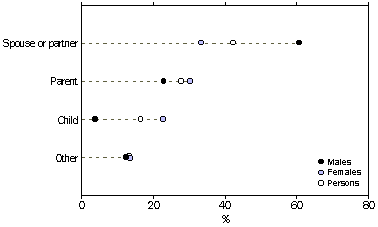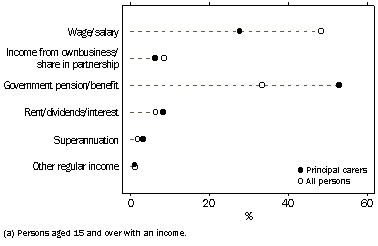|
|
INTRODUCTION
The family is 'the basic unit of society: ...it continues to provide the natural framework for the emotional, financial and material support essential to the growth and development of its members, particularly infants and children, and for the care of other dependants, including the aged, disabled and the infirm' (The United Nations' Guidelines for the International Year of the Family, 1994). This publication examines the extent of the need for care of older people and those with disabilities, the role of families and different types of family members in providing this care, and the effects of caring on those who principally undertake it. The report presents an analysis of the current situation of caring and the need for care in response to the issues and questions raised by the changing Australian society.
PEOPLE WITH HANDICAPS
- In 1993, 18% of Australians had a disability. Most of these people, 14% of the total population, had a handicap.
- Almost half (48%) of people with a handicap were aged 60 and over.
- Almost three-quarters (73%) of people with a handicap lived in families, and 6% lived in establishments.
- There were 721,000 people with a profound or severe handicap. Of these two-thirds lived in a family.
- Of people with a handicap who lived at home, 39% needed help with home maintenance, and 29% needed help with transport.
- Six in 10 people with a handicap who lived in a household and needed help received as much help as they needed.
- People born in a non-English speaking country and in an English speaking country had a similar chance of having their needs for assistance fully met, (66% and 62% respectively).
- Around 7% of people needing help received no help at all.
- Ninety-two percent of people with a handicap who received informal care received care for some activities from a family member.
ALL PERSONS(a): DISABILITY STATUS BY LIVING ARRANGEMENTS |
|
 | Disability status |  |  |
 |
|  |  |
 |  | Diability without | Total with Disability |  |  |
| Living arrangements | Handicap | handicap |  | No disability | Total |
 |
|
| Lives in household |  |  |  |  |  |
|
|  |  |  |  |  |
|
| 72.9 | 79.9 | 74.2 | 89.3 | 86.5 |
|
| 2.9 | 3.6 | 3.1 | 5.0 | 4.7 |
|
| 18.7 | 14.2 | 17.7 | 5.7 | 7.8 |
|
| 94.3 | 97.7 | 95.0 | 99.9 | 99.1 |
| |  |  |  |  |  |
| Lives in establishment | 5.7 | 2.3 | 5.0 | 0.1 | 0.9 |
 |  |  |  |  |  |
| All persons | 100.0 | 100.0 | 100.0 | 100.0 | 100.0 |
| Number ('000) | 2,500.2 | 676.4 | 3,176.7 | 14,417 | 17,597.3 |
|
(a) Excludes boarding school pupils.
(b) Comprises unrelated individuals living together, or with families.
OLDER PEOPLE
- In 1993, there were 2.8 million people aged 60 and over. Just over two-thirds lived in a family.
- Over half (56%) of all people aged 60 and over who lived in households felt that they needed no help or assistance, because of their age or disability, with activities connected with their daily life.
- Around a quarter (24%) of people aged 60 and over had a profound handicap which meant that they always needed help in a basic living activity.
- Among those aged 80 and over, close to half always needed help or supervision because of their handicap.
- Of the people aged 60 and over who needed help, 74% of those who lived in a family had their needs fully met compared with 61% not living in a family.
- Twenty-seven percent of people who were aged 60 and over, with unmet need, did not consider that their need for help was important enough to seek assistance from a formal service.
- Family members provided over 80% of the assistance given to people aged 60 and over, Friends often provide help with transport, mobility and home maintenance.
- In 1993, 157,000 people aged 60 and over were principal carers.
PERSONS AGED 60 YEARS AND OVER WHO WERE LIVING IN HOUSEHOLDS: WHETHER NEEDED HELP AND EXTENT TO WHICH NEEDS MET BY WHETHER LIVED IN A FAMILY |
|
 |  |  |  |  |  |  |  |
| Whether needed help and | Lives in a family | Does not live in a family |  |
| extent to which needs met | Males | Females | Person | Males | Females | Person | Total |
 | % | % | % | % | % | % | % |
 |  |  |  |  |  |  |  |
| Help needed |  |  |  |  |  |  |  |
|
| 67.4 | 77.3 | 73.8 | 61.6 | 60.3 | 60.5 | 69.4 |
|
| 23.6 | 19.9 | 21.2 | 19.8 | 29.8 | 28.0 | 23.5 |
|
| 9.0 | 2.8 | 5.0 | 18.6 | 10.0 | 11.5 | 7.2 |
|
| 100.0 | 100.0 | 100.0 | 100.0 | 100.0 | 100.0 | 100.0 |
|
| 271.2 | 490.8 | 762.0 | 66.0 | 311.1 | 377.1 | 1,139.0 |
 |  |  |  |  |  |  |  |
Whether needs met not
known(a) | 8.3 | 11.1 | 19.4 | - | **0.1 | **0.1 | 19.5 |
 |  |  |  |  |  |  |  |
| Total help needed ('000) | 297.5 | 501.9 | 981.4 | 66.0 | 311.1 | 377.2 | 1,158.5 |
 |  |  |  |  |  |  |  |
| Help not needed ('000) | 707.9 | 400.6 | 1,108.5 | 142.5 | 209.4 | 351.9 | 1,460.4 |
 |  |  |  |  |  |  |  |
All persons 60 and over
living in households ('000) | 987.4 | 902.5 | 1,889.9 | 208.6 | 520.5 | 729.1 | 2,619.0 |
|
(a) People receiving help with verbal communication were not asked if they received enough help.
PROVIDERS OF CARE
- In 1993, there were 1.5 million carers who were caring for another person in the same household. Just over 6% of these provided care for more than one person.
- There were 1.4 million people who received care from another person in the same household. Twenty percent of these had more than one carer.
- Fifty-four percent of all carers who lived in the same household as the person receiving care were men.
- Sixty-six percent of male carers cared for a partner, compared with 53% of female carers.
- Over a quarter (26%) of carers who lived with the person whom they cared for were principal carers.
PRINCIPAL CARERS
- Ninety-five percent of principal carers were providing care to a family member.
- Forty-two percent of all principal carers were providing care to their partner.
- Less than half (38%) of principal carers of a parent lived in the same household as their parent.
- Twenty percent of those caring for a child had been in the caring role for 20 years or longer.
PRINCIPAL CARERS: RELATIONSHIP OF RECIPIENT OF CARE TO CARER

IMPACT OF THE CARING ROLE
- Eighty-three percent of employed men aged 15 to 64 caring for partners were in full-time employment compared with 48% of employed women.
- People caring for parents experienced closer to average employment patterns than those caring for a partner or child.
- Thirty-seven percent of women who worked prior to the caring role had given up work because of the caring role.
- In 1993, more than half of all principal carers with an income (52%) had a personal weekly income of $200 or less.
PRINCIPAL SOURCE OF INCOME(a)

- Ninety-three thousand principal carers were not able to go out during the day or could only go out if help was arranged, or they were accompanied by the person whom they cared.
- Twenty-one percent of all principal carers said their sleep was interrupted by the caring role and that this affected their daily activities.
- One hundred thousand principal carers reported that they had lost touch or were loosing touch with existing friends.
- Thirty-one percent of carers for children reported that their relations with other family members were strained.
- Principal carers of partners or children were more likely to report stress related illness, worry depression, anger or lack of energy than those caring for other people.
PRINCIPAL CARERS: PHYSICAL AND EMOTIONAL WELL-BEING BY RECIPIENT OF CARE |
|
 |  |  |  |  |  |
| Effect of caring role on carer's | Spouse or |  |  |  |  |
| physical and emotional well-being | partner | Parent | Child | Other | Total(a) |
 | % | % | % | % | % |
 |  |  |  |  |  |
| No change | 33.3 | 35.3 | 20.1 | 41.4 | 32.8 |
| Feels satisfied | 14.6 | 23.3 | 17.7 | 29.6 | 19.5 |
| Weary or lacks energy | 28.4 | 21.5 | 41.2 | 18.6 | 27.3 |
| Worried, depressed or angry | 30.4 | 28.0 | 44.7 | 22.8 | 31.0 |
| Diagnosed with stress related illness | 14.6 | 8.4 | 20.4 | *7.6 | 12.9 |
 |  |  |  |  |  |
| All principal carers(a) | 100.0 | 100.0 | 100.0 | 100.0 | 100.0 |
| Number ('000) r | 229.1 | 150.9 | 89.3 | 71.9 | 541.2 |
|
(a) Persons may indicate more than one type of effect and therefore components do not add to total.
SUPPORT FOR CARERS
- Principal carers of a child were more likely to than other groups to have received training for the caring role.
- Twenty-eight percent of all principal carers who were caring for a spouse received help with the caring role. Principal carers of other groups, such as parents or children, were twice as likely to have received help.
|
 Print Page
Print Page
 Print All
Print All